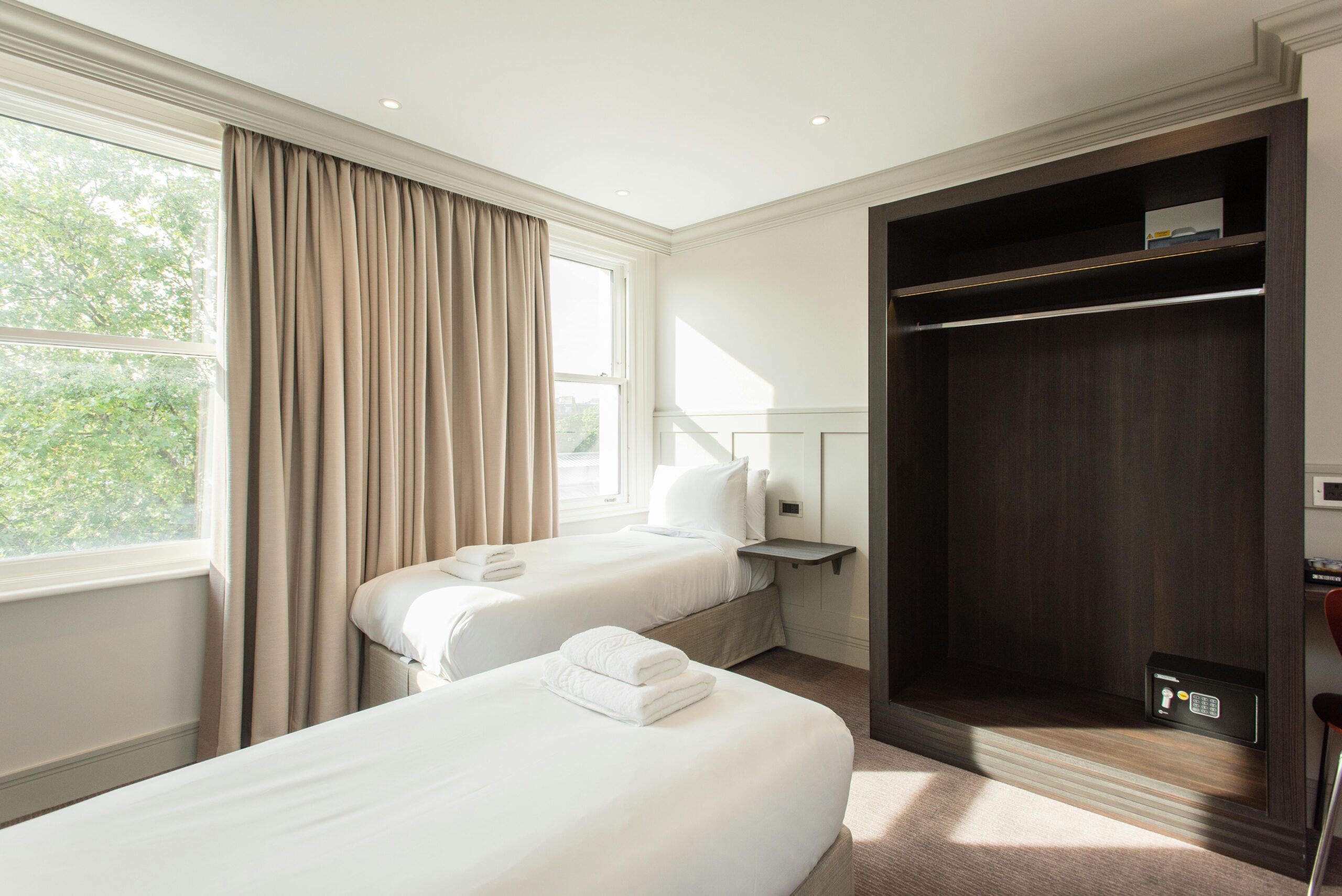When it comes to choosing the perfect place to stay during your travels, clean hotels play a crucial role in ensuring your ultimate comfort and safety. Have you ever wondered how some hotels maintain that impeccable cleanliness that instantly makes you feel at ease? In this article, we will unveil the secrets behind hotel hygiene standards and reveal how these establishments go above and beyond to create a safe, spotless environment for every guest. Whether you’re a frequent traveler or planning a special getaway, understanding what makes a hotel truly clean can transform your stay from ordinary to extraordinary.
In today’s world, where health and safety have become top priorities, spotless hotel rooms and sanitized hotel facilities are more important than ever. From advanced cleaning technologies to rigorous staff training, clean hotels implement a variety of cutting-edge sanitation protocols that guarantee a germ-free experience. But what exactly sets a clean hotel apart from the rest? Is it just about having tidy rooms, or is there a hidden science behind the sparkle? Dive in as we explore the innovative methods and industry-leading practices that make clean hotels a haven of comfort and peace of mind.
Moreover, the rise of eco-friendly hotel cleaning products and sustainable practices adds a new dimension to how hotels maintain cleanliness while caring for the environment. Imagine staying in a hotel that not only prioritizes your health but also contributes to a greener planet! Stay tuned to discover how clean hotels blend safety, comfort, and sustainability to redefine your travel experience. Ready to learn the insider tips on choosing the best clean hotels for your next trip? Let’s get started!
7 Proven Cleaning Protocols Top Clean Hotels Use to Guarantee Your Safety and Comfort
In New York, where travelers come from all over the world, the importance of clean hotels cannot be overstated. After all, your safety and comfort depend on the cleanliness standards the hotel maintain. But what really goes behind the scenes to make sure your room is spotless and safe? Many top clean hotels have developed protocols that not only make the environment hygienic but also give you peace of mind during your stay. Let’s explore 7 proven cleaning protocols top clean hotels use to guarantee your safety and comfort, and how these methods have evolved to meet guest expectations.
1. Deep Cleaning and Disinfection Regimens
One of the most critical steps that clean hotels take seriously is deep cleaning and disinfection. This isn’t just about wiping surfaces quickly; it involves thorough sanitization of high-touch areas like door handles, light switches, remote controls, and elevator buttons. Hotels use EPA-approved disinfectants that are proven to kill viruses and bacteria. Historically, after outbreaks like SARS and H1N1, the hospitality industry started to adopt more rigorous cleaning methods. Today, these protocols are standard, especially as guests expect safer environments post-pandemic.
- Use of hospital-grade disinfectants
- Frequent cleaning of public spaces
- Scheduled deep cleaning of guest rooms after each stay
2. Use of Advanced Cleaning Technologies
Technology plays a big role in how clean hotels assure safety. Many hotels in New York have begun using ultraviolet (UV) light devices to sterilize rooms. UV light kills microorganisms by destroying their DNA, which traditional cleaning might miss. Robots equipped with UV technology or electrostatic sprayers are becoming common in luxury and mid-range hotels alike.
Examples include:
- UV-C light robots roaming public areas
- Electrostatic sprayers that coat surfaces evenly
- HEPA air purifiers to reduce airborne contaminants
This tech enhances traditional cleaning and reduces human error, but it’s not replacing manual labor completely.
3. Staff Training and Personal Hygiene Protocols
A clean hotel is only as good as its staff commitment to hygiene. Top hotels invest heavily on employee training about proper cleaning techniques, use of personal protective equipment (PPE), and hand hygiene. Staff are taught the importance of wearing gloves and masks, changing them regularly, and sanitizing hands after every cleaning session.
Additionally, hotels often require:
- Daily health checks for housekeeping staff
- Regular training updates on new cleaning standards
- Clear guidelines on waste disposal and linen handling
This protocol minimizes cross-contamination and ensures that the people responsible for cleanliness don’t become sources of infection.
4. Enhanced Linen and Laundry Procedures
Linens, towels, and bedding can harbor germs if not washed correctly. Clean hotels use high-temperature washing cycles, typically above 160°F (71°C), which kill most bacteria and viruses. They also separate used linens from clean ones carefully to avoid cross-contamination.
Some key laundry practices include:
- Using hospital-grade detergents and disinfectants
- Sealing clean linens in protective packaging before room delivery
- Frequent replacement of linens, sometimes daily or upon guest request
Though it sounds simple, laundry protocols have become more stringent, especially in hotels catering to health-conscious travelers.
5. Contactless Check-in and Digital Services
To reduce physical contact, many clean hotels in New York have adopted contactless check-in systems. Guests can use mobile apps or kiosks to check in, get room keys digitally, and even order room service through their phones. This reduces the number of times staff and guests interact, lowering the risk of virus transmission.
Benefits of contactless services:
- Minimizes face-to-face interaction
- Speeds up check-in and check-out process
- Allows guests to control environment settings (lighting, temperature) remotely
This protocol is part of the hotels’ efforts to combine convenience with safety.
6. Air Quality Management
Indoor air quality is often overlooked but it’s very important in maintaining clean hotel environments. Many hotels use upgraded HVAC filters like MERV-13 or higher that trap smaller particles. Some even install UV lights inside air ducts to kill airborne pathogens.
Hotels also increase ventilation rates by:
- Opening windows where possible
- Using portable air purifiers in rooms and lobbies
- Monitoring humidity levels to prevent mold growth
These measures help ensure that the air you breathe inside the hotel is cleaner and safer.
7. Transparent Communication with Guests
Lastly, clean hotels understand the importance of transparency. They communicate clearly with guests about their cleaning protocols, what to expect during their stay, and how guests can contribute to safety. This might be through welcome booklets, websites, or signage in public areas.
Typical communication points:
- Detailing cleaning schedules and products used
- Requesting guests to use hand sanitizers placed around the hotel
- Encouraging guests to report any cleanliness concerns immediately
When hotels share this information openly, guests feel more confident and comfortable.
To sum it all up, clean hotels in New York aren
How Clean Hotels Leverage Advanced Technology for Unmatched Hygiene Standards
How Clean Hotels Leverage Advanced Technology for Unmatched Hygiene Standards
Hotels in New York and beyond have been facing increasing challenges to maintain cleanliness standards, especially after the global pandemic shifted guest expectations dramatically. Clean hotels aren’t just about tidy sheets and shiny floors anymore. Instead, they now relies on advanced technology to ensure your ultimate comfort and safety during every stay. This article explores how modern hotels are adopting new tools and methods to provide unmatched hygiene standards, proving that clean hotels truly care about your well-being.
Why Clean Hotels Matter More Than Ever
People traveling today don’t just want a nice bed and good service, they demand a guarantee that the environment they enter is safe and sanitary. Historically, hotels have focused on visible cleanliness, like vacuuming carpets and changing towels. But unseen pathogens on surfaces or in the air could still pose risks. Clean hotels must now go beyond the surface.
For example, studies shows that high-touch areas such as door handles, elevator buttons, and remote controls can harbor bacteria and viruses. So, it’s not just about looking clean, but proving that the hotel environment reduces the chance of infection. This shift comes after health crises such as SARS, MERS, and COVID-19, which exposed how crucial hygiene is in public spaces.
Technologies Transforming Clean Hotels
Many hotels in New York City and worldwide adopt cutting-edge technology to maintain high hygiene standards. These innovations include:
- UV-C Light Sanitization: Ultraviolet light in the UV-C spectrum can kill bacteria and viruses by disrupting their DNA. Some hotels use UV-C robots to disinfect rooms and common areas quickly and effectively.
- Electrostatic Sprayers: These devices apply disinfectant with an electrostatic charge, ensuring the liquid wraps around surfaces and reaches hidden spots.
- Air Purification Systems: Advanced HEPA filters and ionizers remove airborne particles and pathogens, improving indoor air quality.
- Touchless Technology: From contactless check-in kiosks to automatic doors and voice-activated controls, reducing physical contact minimizes contamination risks.
- Smart Cleaning Robots: Automated vacuum cleaners and floor scrubbers that operate frequently to maintain spotless environments without human fatigue or error.
Practical Examples of Clean Hotels In New York
Hotels like the Marriott Marquis, Hilton Midtown, and the Westin New York have been pioneers integrating these technologies. For instance, the Marriott Marquis employs UV-C robots to sanitize guest rooms after checkout, reducing cleaning time and human error. Hilton Midtown offers mobile key access and digital check-in to avoid crowded front desks.
Here’s a quick comparison table illustrating how some clean hotels in New York use technology:
| Hotel Name | UV-C Light Use | Touchless Tech | Air Purification | Automated Cleaning Robots |
|---|---|---|---|---|
| Marriott Marquis | Yes | Mobile check-in | HEPA filters in HVAC | Yes |
| Hilton Midtown | Limited (common areas) | Mobile key, voice control | Advanced ionizers | Yes |
| Westin New York | Yes | Contactless payments | HEPA and UV air treatment | No |
How These Technologies Help Guests Feel Safer
The integration of technology does not only improve physical cleanliness but also enhances guest confidence. When travelers see a hotel using robots to clean or offering contactless solutions, they feel reassured that their health is prioritized. This psychological comfort is just as important, especially for families, seniors, or business travelers who are more vulnerable.
It’s worth noting, however, that technology alone cannot replace good old-fashioned cleaning staff. Many hotels combine human expertise with tech tools for best results. Staff receive special training on how to use these devices properly and follow strict protocols for sanitization.
Additional Measures Clean Hotels Implement
Besides technology, clean hotels adopt several other practices to keep guests safe and comfortable such as:
- Increased frequency of cleaning in high-traffic areas
- Use of hospital-grade disinfectants approved by health authorities
- Proper ventilation systems ensuring fresh air circulation
- Temperature checks and health screenings for staff
- Clear communication with guests on hygiene policies and expectations
Bullet-point list of common cleaning protocols:
- Daily deep-cleaning of guest rooms and bathrooms
- Sanitizing elevator buttons every hour
- Providing hand sanitizer stations throughout the property
- Laundering linens at high temperatures
- Isolating rooms after guest checkout before new arrivals
Historical Context: How Cleanliness Standards Evolved in Hotels
Hotel hygiene standards have come a long way since the early 20th century when public health awareness was minimal. It was during the 1918 Spanish flu pandemic that many hotels started adopting stricter cleaning routines. Later outbreaks like SARS in 2003 and H1N1 in 2009 further pushed the hospitality industry to consider infection control seriously.
The COVID-19 pandemic accelerated the adoption of digital and automated cleaning technologies dramatically. Hotels had to innovate fast to meet new
Why Choosing Clean Hotels with Eco-Friendly Practices Enhances Your Stay Experience
Choosing where to stay during your trip can make or break the whole experience. Nowadays, more travelers are paying attention to clean hotels that also embrace eco-friendly practices. This combo is not just about looking nice or being trendy; it directly impacts your comfort, safety, and even the environment. You might not realize it, but picking a hotel that prioritizes cleanliness and sustainability changes the way you enjoy your stay in ways you never expected.
Why Clean Hotels Matter Beyond Just Appearance
Cleanliness in hotels isn’t just about making the beds or wiping the surfaces. It’s a whole system that ensures guests feel safe and relaxed. If a hotel skimp on cleanliness, you risk exposed to germs, allergens, or even pests. These things can ruin a vacation or business trip fast and maybe cause health problems.
Historically, hotels started focusing seriously on hygiene after major disease outbreaks in the 19th century. For example, during the cholera outbreaks, better sanitation in lodging houses was pushed by governments to control infection spread. So, clean hotels today are result of decades of learning and regulations designed to protect guests.
- Clean hotels regularly sanitize high-touch areas like door handles, elevator buttons, and remote controls.
- They use hypoallergenic bedding and frequently wash linens at high temperatures to kill bacteria.
- Bathrooms are deep cleaned daily, with attention to mold prevention and fresh towels.
- Public spaces like lobbies and gyms follow strict cleaning schedules to maintain hygiene.
Without these measures, a hotel stay could feel unsafe and uncomfortable. Guests want to rest and recharge without worrying about hidden dirt or germs lurking around.
Eco-Friendly Practices: More Than Just Green Marketing
Eco-friendly hotels do more than just put a recycling bin in the lobby. They implement strategies that reduce their environmental footprint while improving guest experience. This means using less water, energy, and creating less waste without sacrificing comfort.
Some of the common eco-friendly practices in clean hotels include:
- Installing LED lighting and energy-efficient appliances that reduce electricity use.
- Water-saving fixtures such as low-flow showerheads and toilets.
- Using non-toxic cleaning products that are safer for both guests and environment.
- Encouraging guests to reuse towels and linens to save water and detergent.
- Offering locally sourced food and beverages to cut down transportation emissions.
- Using renewable energy sources like solar panels in some cases.
A hotel in New York, for example, might have rooftop gardens that help reduce urban heat and provide fresh herbs for their kitchen. These efforts not only protect the planet but also create a unique, calming atmosphere for guests.
How Clean and Eco-Friendly Hotels Enhance Your Comfort and Safety
When a hotel focuses on both cleanliness and sustainability, you get a better stay experience overall. Here’s why:
- Health Protection: Using eco-friendly cleaning products means less exposure to harsh chemicals that can cause allergies or irritations. Plus, thorough cleaning reduces the chance of infections.
- Better Air Quality: Many green hotels invest in air purification systems and avoid synthetic fragrances, making the air fresher and easier to breathe.
- Noise Reduction: Sustainable building materials and design often include soundproofing, so your room stays quiet and peaceful.
- Temperature Control: Energy-efficient heating and cooling systems provide more consistent room temperatures without wasting resources.
- Peace of Mind: Knowing the hotel cares about environment and hygiene makes you feel more relaxed and valued as a guest.
Comparison Between Standard Hotels and Clean, Eco-Friendly Hotels
| Aspect | Standard Hotels | Clean & Eco-Friendly Hotels |
|---|---|---|
| Cleaning Products | Often use strong chemicals | Use biodegradable, non-toxic cleaners |
| Energy Consumption | Less focus on efficiency | Employ energy-saving technologies |
| Water Usage | Standard fixtures | Low-flow faucets and showerheads |
| Waste Management | Minimal recycling | Comprehensive recycling and composting |
| Guest Health Benefits | Basic sanitation | Enhanced hygiene with safer products |
| Environmental Impact | Higher pollution and waste | Lower carbon footprint |
This table shows how much better clean and green hotels perform in areas that matter to guests and planet alike.
Practical Tips to Identify Clean Hotels with Eco-Friendly Practices
If you want to choose a hotel that ticks both boxes, here some tips that will help:
- Look for certifications like LEED, Green Key, or EarthCheck. These prove the hotel meets certain environmental and health standards.
- Read recent guest reviews focusing on cleanliness and sustainability efforts.
- Check the hotel website or call ahead to ask about their cleaning protocols and eco initiatives.
- See if they provide reusable water bottles, recycling bins, or have policies about towel and linen reuse.
- Prefer hotels that partner with local suppliers or support community-based projects.
- Pay attention to the kind of toiletries and cleaning products they use – natural ingredients are a good sign.
A Growing Trend in the New York Hotel Scene
In a bustling city like New
The Ultimate Guide to Spotting Truly Clean Hotels: What Guests Need to Know
Traveling to New York or anywhere else bring excitement, but sometimes it also bring worries about where you gonna stay. One major concern for guests is cleanliness. Everyone wants to rest in a hotel that is clean, safe, and comfortable. But how you can really tell if a hotel is truly clean? This guide will help you spot clean hotels and understand how they ensure your ultimate comfort and safety.
What Makes a Hotel Truly Clean?
Clean hotels do more than just look tidy. They have strict hygiene protocols which they follows every day. Cleanliness means all surfaces, linens, bathrooms, and public areas are sanitized properly to kill germs and bacteria. A hotel might look shiny but it doesn’t always mean it’s clean in the way it counts — free from harmful microbes.
Hotels that place cleanliness as a priority often adopt standards set by health organizations or hospitality associations. For example, many hotels now use disinfectants approved by the Environmental Protection Agency (EPA) or follow guidelines from the Centers for Disease Control and Prevention (CDC). These steps helps to minimize the risk of infections spreading among guests.
Historical Context: Cleanliness in Hotels Through Time
Before the 20th century, hygiene standards in hotels were inconsistent. Often, travelers found themselves in places with poor sanitation which could lead to illnesses. The industrial revolution and rise of tourism pushed hotels to improve their cleaning practices. The invention of modern plumbing and disinfectants made a big difference.
In recent years, the COVID-19 pandemic has accelerated the importance of cleanliness in hospitality. Hotels had to upgrade their cleaning procedures quickly, introducing contactless check-ins and more frequent sanitization. Now, cleanliness is no longer just a courtesy but an essential part of guest safety.
How To Spot a Truly Clean Hotel: Practical Tips
It is not always easy to judge a hotel’s cleanliness from pictures alone. Here are some practical ways you can check if a hotel is truly clean before you book or during your stay:
- Read Recent Reviews: Look for guest comments about cleanliness, specifically mentioning bathrooms, linens, and common areas.
- Check Certification: Some hotels display cleanliness certification or badges from health authorities or third-party auditors.
- Observe the Lobby and Public Spaces: These areas are cleaned more frequently. If these looks dirty or dusty, room cleanliness might be questionable.
- Inspect Your Room: Upon arrival, check under the bed, behind furniture, and inside drawers for dust or dirt.
- Smell Test: Strange or musty odors might indicate poor cleaning or ventilation problems.
- Linens and Towels: White linens that are bright and fresh usually indicate good laundry practices.
- Bathroom Cleanliness: Tiles, faucets, and toilets should be spotless and free from mold or stains.
- Ask Staff About Cleaning Procedures: Don’t hesitate to ask how often rooms are cleaned or what disinfectants are used.
Clean Hotels vs. Regular Hotels: What Sets Them Apart?
| Aspect | Clean Hotels | Regular Hotels |
|---|---|---|
| Cleaning Frequency | Multiple times per day in public and rooms | Usually once per day or less |
| Disinfectants Used | EPA-approved, hospital-grade | Basic detergents or soaps |
| Staff Training | Regular hygiene and safety training | Minimal or occasional training |
| Guest Amenities | Hand sanitizers, disposable items | Standard toiletries only |
| Air Quality | Enhanced ventilation and air purifiers | Standard HVAC systems |
| Transparency | Open about cleaning protocols | Limited information |
Clean hotels have invested in technology and training to raise cleanliness standards. Many now use UV light sanitation or electrostatic sprayers which disinfect surfaces more effectively than traditional methods.
Discover How Clean Hotels Ensure Your Ultimate Comfort and Safety
Comfort and safety go hand in hand with cleanliness. Clean hotels understand this and tailor their services accordingly. For example, they provide individually wrapped amenities like toothbrushes and razors to prevent contamination. Bedding is often changed more frequently, and some hotels even offer hypoallergenic options for sensitive guests.
Moreover, clean hotels may enforce mask-wearing or social distancing in public areas during health crises. They might also limit the number of guests using facilities like gyms or pools to maintain hygiene standards.
Another important factor is staff behavior. Clean hotels employ staff who are not only trained in cleaning but also in guest interaction demonstrating professionalism and attentiveness to hygiene concerns.
Practical Example: Two New York Hotels Compared
To illustrate, let’s look at two hotels in New York — Hotel A and Hotel B.
Hotel A advertises “enhanced cleaning” but guest reviews mention inconsistent cleaning and dusty corners. The hotel uses basic cleaning agents and has no visible certification. It also lacks hand sanitizer stations in the lobby.
Hotel B, on the other hand, has third-party cleanliness certification. It uses hospital-grade disinfectants and its staff undergo weekly training sessions. Guests consistently praise the spotless rooms and fresh linens. Hand
Are Clean Hotels the New Standard? Exploring Post-Pandemic Hygiene Trends in Hospitality
Are Clean Hotels the New Standard? Exploring Post-Pandemic Hygiene Trends in Hospitality
The world has changed a lot since the pandemic began, and one of the biggest shifts you might notice while traveling is the emphasis on cleanliness in hotels. Are clean hotels the new standard? Well, many travelers now expect not only comfort but also reassurance about hygiene and safety when they book a room. This article dive into the rise of clean hotels, why they matter more than ever, and how hospitality industries in places like New York are adapting to meet these demands.
Why Clean Hotels Gained Importance Post-Pandemic
Before 2020, cleanliness was always important in hospitality, but it wasn’t usually the main selling point. Guests cared about good beds, friendly service, and maybe a nice breakfast. However, COVID-19 brought about a global awareness of germs and disease transmission. Suddenly, people wanted to know if the hotel room was sanitized properly, if public spaces were regularly disinfected, and if staff were trained to handle health risks.
Hospitals and healthcare settings have always strict hygiene standards, but hotels had to quickly learn and adapt. This urgency made clean hotels not just a perk but a necessity. According to a survey by the American Hotel & Lodging Association in 2021, over 80% of guests said cleanliness was the most critical factor when choosing a place to stay. That’s a huge jump from previous years.
What Does a Clean Hotel Look Like Now?
The clean hotel of 2024 looks different than the clean hotel of 2019. It’s not just about visible tidiness but about deeper sanitization procedures, new technology, and clear communication to guests. Here are some common features you might find:
- Enhanced cleaning protocols: Hotels use hospital-grade disinfectants on high-touch surfaces like doorknobs, elevator buttons, and remote controls.
- Contactless check-ins: To reduce physical contact, many establishments offer mobile key cards and online check-in options.
- Air quality improvements: Increased ventilation and use of HEPA filters in HVAC systems to reduce airborne contaminants.
- Staff training: Employees receive rigorous hygiene training and are often required to wear masks or gloves.
- Visible cleaning schedules: Some hotels display cleaning checklists in public areas so guests can see when spaces were last sanitized.
- Sanitizer stations: Hand sanitizer dispensers placed throughout lobbies, gyms, and other common areas.
Clean Hotels vs Traditional Hotels: A Quick Comparison
| Aspect | Traditional Hotels (Pre-Pandemic) | Clean Hotels (Post-Pandemic Trend) |
|---|---|---|
| Cleaning Frequency | Daily room cleaning, weekly deep clean | Multiple daily cleanings, frequent disinfection |
| Technology Use | Standard check-in and key cards | Mobile check-in, contactless payments |
| Air Circulation | Basic HVAC systems | Enhanced filtration and ventilation |
| Guest Interaction | Face-to-face with staff | Minimal contact, digital communication |
| Staff Safety Measures | Basic hygiene protocols | Masks, gloves, regular health checks |
How Clean Hotels Ensure Your Ultimate Comfort and Safety
Clean hotels are making sure guests feel safe and comfortable in many practical ways. For example, many New York hotels now offer room service with sealed packaging, so food delivery is completely contactless. This reduces the risk of contamination and gives guests peace of mind.
In addition, some hotels have started to use UV light technology to disinfect rooms between stays. UV light can kill bacteria and viruses on surfaces without harsh chemicals, offering an eco-friendly sanitation method.
Hotels also invest in better bedding materials that are antimicrobial or easier to wash. Pillows, mattress covers, and linens are changed more frequently, sometimes after every guest, which wasn’t always the case before.
Practical Tips for Travelers Looking for Clean Hotels
If you’re someone who prioritizes cleanliness when booking a hotel, here are few tips to help you find a truly clean hotel:
- Check reviews: Look for recent guest comments specifically mentioning cleanliness.
- Visit official hotel websites: Many hotels now outline their cleaning protocols online.
- Ask questions: Don’t hesitate to call the hotel and ask about their sanitation measures.
- Look for certifications: Some hotels have third-party clean certifications like the GBAC STAR or SafeStay.
- Observe on arrival: Notice if sanitizer stations are available and if staff follow hygiene protocols.
Long-Term Impact on Hospitality Industry
Clean hotels are not just a temporary trend but could be the new foundation for the hospitality industry going forward. Travelers now expect transparency and accountability about hygiene, and hotels that fail to deliver may lose business. Cleaning innovations and health safety investments can also improve overall guest experience beyond pandemic concerns.
Moreover, the focus on cleanliness drive innovation in the sectors such as eco-friendly cleaning products
Conclusion
In conclusion, prioritizing cleanliness in hotels is essential not only for guest satisfaction but also for ensuring health and safety standards are met. Throughout this article, we explored the critical role that rigorous cleaning protocols, the use of eco-friendly products, and staff training play in maintaining impeccable hygiene. Clean hotels foster a welcoming environment that enhances the overall guest experience, builds trust, and encourages repeat visits. Moreover, in today’s health-conscious world, transparency about cleaning practices has become a key factor in travelers’ decision-making processes. As the hospitality industry continues to evolve, embracing innovative cleaning technologies and sustainable practices will set clean hotels apart from the competition. Whether you’re a hotel owner or a traveler, remember that cleanliness is more than just a courtesy—it’s a commitment to well-being. Next time you book a stay, prioritize hotels that demonstrate a genuine dedication to cleanliness and hygiene for a safer, more comfortable journey.













